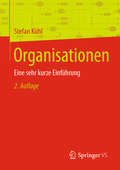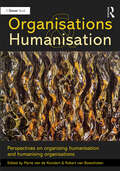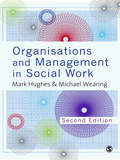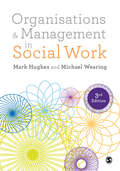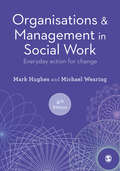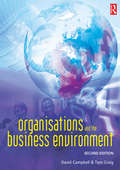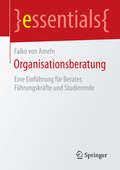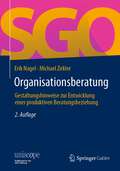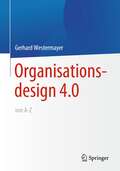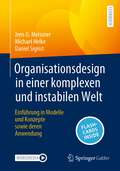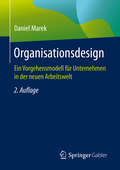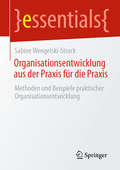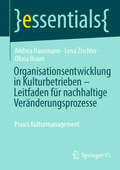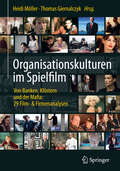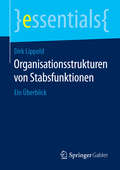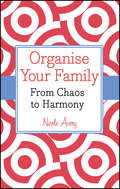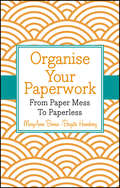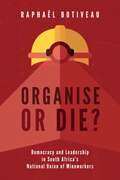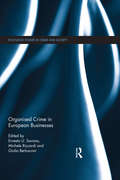- Table View
- List View
Organisationen nachhaltig bewegen: Systemische Organisationsentwicklung zum Nachhaltigen Unternehmen (BestMasters)
by Christiane Lüschen-HeimerOrganisationen sind das Zentrum unserer Gesellschaft. Als solche sind sie Vorreiterinnen in der Entwicklung nachhaltiger Abläufe zur Abwendung der Klimakatastrophe.Dieses Buch lädt ein, Nachhaltigkeit systemtheoretisch zu definieren und bietet über dieses Verständnis ein Haltungs- und Handlungsmodell für den Veränderungsprozess. Er wird möglich, wenn wir Organisationen nicht mehr als Zusammenschluss von Subsystemen und organisationalen Abläufen betrachten. Wenn wir sie in der Einheit von Ökologie, Ökonomie und dem sozialen (menschlichen) Aspekt verstehen, ist eine nachhaltige Transformation möglich. Dann erst ist das Unternehmen/die Organisation den Menschen und der Gesellschaft förderlich. Der systemische Blick auf Organisation und nachhaltige Transformation befähigt Menschen.
Organisationen: Eine sehr kurze Einführung
by Stefan KühlVon der Wiege bis zur Bahre wird unser Leben durch Organisationen bestimmt. Aber wir sind nicht dafür ausgebildet worden, wie wir als Mitglied mit Unternehmen, Verwaltungen, Universitäten, Schulen, Krankenhäusern, Gefängnissen, Parteien oder Armeen zurechtkommen können. Organisationen – was sind das für „Gebilde“, die unsere moderne Gesellschaft so stark bestimmen? Wie "ticken" sie? Welche Eingriffsmöglichkeiten gibt es? Anhand der drei zentralen Merkmale Zwecke, Hierarchie und Mitgliedschaften wird grundlegend erklärt, wie Organisationen funktionieren.
Organisations and Humanisation: Perspectives on organising humanisation and humanising organisations
by Myrte van de Klundert Robert Van BoeschotenThe term humanisation was introduced in humanistic studies to develop a humanist way of thinking about organisations and human relations. It stems from a need to think about questions of justice and living a good life in practice but not from some absolute or abstract point of view. As it is often framed, humanisation is concerned with working towards a more human type of organisation. Organisation studies are concerned with understanding organisations and their role in our society, and developing perspectives and methods to improve them, while humanisation theories, on the other hand, do not represent a managerial blueprint as they tend to incorporate notions of situated knowledge, sense-making and relational value, drawing our attention to specific processes rather than offering universal truths. Although Critical Management Studies counters mainstream managerialism, it still tends to produce the same kind of ‘truths’ that are supposed to apply to all organisations. Much of the existing management literature is related to control and offers strategies on how to do things but this is not about prescriptions, rather how to explore possibilities from both theoretical and practical perspectives. It offers managers as well as theoreticians of organisations the possibility to question their grounding principles. In the variety of contributions to this book the authors reflect on their understanding of what it is to be human and whether this can be found in the way that organisations are run. They consider the value of humanisation to understand and intervene in organisations and the challenges they face.
Organisations and Management in Social Work
by Mark Hughes Dr Michael WearingThe second edition of Organisations and Management in Social Work examines the complex organisational settings in which social workers practice and identifies opportunities for taking action for positive change. A robust critique of organisational practices is encouraged throughout the book with an emphasis on active participation in the everyday life of organisations. The new edition covers: - Leadership and supervision - Inter-agency and inter-disciplinary working - Ethical practice and decision-making - Communication and the emotional life of organisations Each chapter includes updated practice examples and reflective questions so readers can apply the knowledge learned to real life practice. It will be essential reading for undergraduate and postgraduate students of social work. The book will also be a valuable text for front-line practitioners and managers wishing to understand the organisational context of social work.
Organisations and Management in Social Work: Everyday Action for Change
by Mark Hughes Michael WearingProviding a comprehensive and critical examination of the complex issues involved in the management and organisational contexts of social work practice, this book will help readers to: - Critically evaluate organisational theory, managerial techniques and organisational structures. - Develop strategies for ethical and reflective organisational practice. - Understand how to plan and manage change in learning organisations. - Unpick important themes such as leadership, supervision, risk, decision making, and accountability. - Explore the potential for increasing service user and worker participation in organisations.
Organisations and Management in Social Work: Everyday Action for Change
by Mark Hughes Michael WearingProviding a comprehensive and critical examination of the complex issues involved in the management and organisational contexts of social work practice, this book will help readers to: - Critically evaluate organisational theory, managerial techniques and organisational structures. - Develop strategies for ethical and reflective organisational practice. - Understand how to plan and manage change in learning organisations. - Unpick important themes such as leadership, supervision, risk, decision making, and accountability. - Explore the potential for increasing service user and worker participation in organisations.
Organisations and Management in Social Work: Everyday Action for Change
by Mark Hughes Michael WearingAs a social worker, you could work in a variety of different organisations, each with their own purpose, culture and structure. Understanding and examining the complex issues involved in the management and organisational context of social work practice is crucial for practitioners and managers. This book helps you to develop strategies for ethical, reflective and relational practice, covers key themes including leadership, supervision, risk and decision making and emphasises the importance of active participation for positive change. Thoroughly updated, and with new Practice Examples demonstrating the relationship between theory and practice, this is essential reading for both undergraduate and postgraduate students of social work, as well as practising social workers.
Organisations and Management in Social Work: Everyday Action for Change
by Mark Hughes Michael WearingAs a social worker, you could work in a variety of different organisations, each with their own purpose, culture and structure. Understanding and examining the complex issues involved in the management and organisational context of social work practice is crucial for practitioners and managers. This book helps you to develop strategies for ethical, reflective and relational practice, covers key themes including leadership, supervision, risk and decision making and emphasises the importance of active participation for positive change. Thoroughly updated, and with new Practice Examples demonstrating the relationship between theory and practice, this is essential reading for both undergraduate and postgraduate students of social work, as well as practising social workers.
Organisations and the Business Environment
by David Campbell Tom CraigThis new edition of Organisations and the Business Environment provides a completely revised, extended and updated edition of the original successful text. It provides contemporary and comprehensive coverage of the subject matter which is highly relevant to business and management students at undergraduate, postgraduate and professional levels. The text is written in a clear and concise style, illustrated with topical examples and data.Organisations and the Business Environment (second edition) comprises four sections:* Business Organisations ¡V discusses the evolution of organisational and managerial theories and concepts with particular emphasis on their relevance in the 21st century. The different types of organisations and their missions, visions, goals and objectives are examined.* The External Business Macro-Environment ¡V describes and considers the political, economic, socio-cultural, technological, ecological and legal influences on organisations, utilizing the PESTEL framework of analysis. This section includes a review of the internationalization of businesses and examines the role of GATT and the WTO, single markets and trading blocs. * The External Business Micro-Environment ¡V provides a review of the market system and the nature of supply and demand. Market structures are examined in the light of monopolistic regimes and working for competitive advantage. The impact of government intervention is explored via regulatory bodies, privatization, and nationalization programmes. * Business Management ¡V explores the major aspects of contemporary business organisations, including corporate governance and business ethics. In particular, this section tackles the areas of structure, culture, change, quality management and the principal functions of organisations. This textbook is a user-friendly resource with end of chapter questions, activities and assignments to consolidate learning. Its strong emphasis on topical examples enables students to understand how theory is applied in business contexts, including, GlaxoSmithKline, BT, Scottish and Newcastle, Hanson plc and a number of not-for-profit organisations.There is additional Tutor Resource material, including presentation slides, data charts, chapter summaries, questions and answers."An excellent book...good use of learning objectives, questions and potential assignments."Paul Blakely, Lecturer, University College of Warrington.
Organisationsberatung: Eine Einführung für Berater, Führungskräfte und Studierende (essentials)
by Falko AmelnFalko von Ameln skizziert einen integrierten Beratungsansatz auf der Basis einer kompakten systemtheoretischen Grundlegung. Erfolgsfaktoren und Herausforderungen in Veränderungsprozessen werden dargestellt und vor dem Hintergrund der Beratungsforschung bewertet, die methodische Gestaltung komplexer Veränderungsprozesse wird im Überblick aufgezeigt. Zwei Kapitel zu ansonsten weniger beachteten Themen analysieren die zukünftige Rolle interner Beratung sowie die latenten Funktionen von Organisationsberatung und ihren Beitrag zur Erklärung der oft irrational erscheinenden Dynamik in Beratungsprozessen. Das Essential schließt mit einem Ausblick in die Zukunft der Organisationsberatung.
Organisationsberatung: Gestaltungshinweise zur Entwicklung einer produktiven Beratungsbeziehung (uniscope. Publikationen der SGO Stiftung)
by Erik Nagel Michael ZirklerKlienten und Berater haben unterschiedliche Bilder und Vorstellungen über Beratungsprozesse. Diese unausgesprochenen Bilder sind handlungsleitend und damit von zentraler Bedeutung für die Arbeitsbeziehung und die Erfolgschancen in der Beratung. Aufgrund ihrer empirischen Forschung ermitteln die Autoren drei typische Bilder und die damit verbundenen Spiele in der Beratungspraxis und geben konkrete Empfehlungen, wie Praktiker ihre eigenen Bilder erkunden und damit ihre Beratungspraxis überprüfen und neu ausrichten können.
Organisationsdesign 4.0 von A-Z.
by Gerhard WestermayerIn diesem Buch geht es um nachhaltige Organisationsentwicklung 4.0. Sie erfahren, wie Freude an der Arbeit bessere Arbeitsergebnisse schafft und Lernerfolge fördert, während Ärger zum Rückgang von Produktivität führt und krank macht. So lernen Sie, wie eine Unternehmenskultur geschaffen werden kann, die Freude und Mitarbeitermotivation steigert und Gefährdungen reduziert, während das Unternehmen Gewinne steigern kann.Analog den 26 Buchstaben des Alphabets wurden aus 16 bekannten Gesundheitspotenzialen für Arbeitsfreude und 10 Gesundheitsgefährdungen diejenigen identifiziert, die für Unternehmen die wichtigsten und stärksten Einflüsse auf die Motivation der Mitarbeiter haben, und damit zum begrifflichen Grundgerüst eines resilienten Organisationsdesign 4.0. gehören. Basierend auf einem Referenzdatenpool, der mehr als 20 000 Befragte aus allen Branchen umfasst, bietet dieses Fachbuch eine wertvolle Analyse und Hilfestellung für Unternehmer, Führungskräfte und Berater.Zielgruppen:Führungskräfte, Personalverantwortliche, Organisationsentwickler, Unternehmer, Betriebsräte, Krankenkassen, etc.Zum Autor: Dr. Gerhard Westermayer ist Autor von mehr als 60 wissenschaftlichen Veröffentlichungen und seit mehr als 30 Jahren erfolgreich in der Organisationsentwicklung tätig.
Organisationsdesign in einer komplexen und instabilen Welt: Einführung in Modelle und Konzepte sowie deren Anwendung
by Jens O. Meissner Michael Heike Daniel SigristOrganisationen aller Art schaffen Zielorientierung und teils unvergleichbare Leistungen, die Einzelne alleine nicht erbringen können. Dieses Lehrbuch untersucht die Entwicklungen und Veränderungen, die Organisationen vornehmen sollten, um in der heutigen komplexen Organisationsumwelt erfolgreich zu sein.Die Autoren erläutern verschiedene Modelle und Konzepte der Organisationsgestaltung, beleuchten die wichtige Rolle, die agiles Management und Selbstorganisation spielen und reflektieren, welche Konsequenzen diese Konzepte für die praktische Organisationsarbeit haben. Die notwendige Organisationsentwicklung ist nur mit Rücksicht auf die bestehende Unternehmenskultur und in Kenntnis der Grundlagen des Wissensmanagements sinnvoll und erfolgreich umzusetzen, so dass auch diese im Lehrbuch vermittelt werden. Übergeordnetes Ziel des Organisationsdesigns ist die Förderung der Krisenrobustheit oder Resilienz der Organisation. Nachdem die Grundlagen dafür gelegt wurden, ist dem Aspekt der Resilienz das vorletzte Kapitel gewidmet, bevor sich ein Ausblick in die Zukunft anschließt. Die didaktische Struktur des Lehrbuchs enthält neben Lernzielen, Praxisbeispielen und Fallstudien sowie Lernverständnis-Fragen auch die Möglichkeit, das eigene Wissen mit den Springer Nature Flashcards zu testen.
Organisationsdesign: Ein Vorgehensmodell für Unternehmen in der neuen Arbeitswelt
by Daniel MarekDieses Fachbuch bietet Führungskräften einen kompakten Überblick über die Formen der Arbeitsteilung und der Koordination, mit denen sie ihrem Unternehmen eine Organisation geben, die zu ihren Zielen und Werten passt. Daniel Marek zeigt, wie Strategie und Struktur sinnvoll aufeinander abgestimmt werden können und was es heißt, die Grundsätze von Selbstorganisation, Agilität und Kontextsteuerung im eigenen Betrieb zu verwirklichen.Viele Instrumente und Verfahren der Organisationslehre passen nicht mehr in eine neue Arbeitswelt oder sind mit hohem Aufwand verbunden. Der Autor präsentiert mit der Design-Leiter ein Modell, das vor allem kleinere und mittlere Unternehmen in die Lage versetzt, organisatorische Fragen in vier Stufen sinnvoll und effizient zu lösen. Zu jedem Schritt werden Verknüpfungen mit der aktuellen Debatte sowie Vorschläge zur Umsetzung und praxistaugliche Instrumente vorgestellt. Checklisten und Tabellen erleichtern die individuelle Umsetzung im eigenen Unternehmen.Für die zweite Auflage wurde das Buch überarbeitet und um neue Erkenntnisse ergänzt, wie etwa die Einbettung agiler Methoden oder einzelne Aspekte soziokratischer Organisationsmodelle.
Organisationsentwicklung aus der Praxis für die Praxis: Methoden und Beispiele praktischer Organisationsentwicklung (essentials)
by Sabine Wengelski-StrockDas Konzept von Organisationsentwicklung soll Kooperation, Partizipation und Transparenz in der Unternehmenskultur verankern:Klarheit in der Kommunikation,transparenter und konstruktiver Umgang mit Konflikten,partizipativer Führungsstil,Offenheit gegenüber Ideen der Mitarbeitenden,Wertschätzung der Leistungen im Unternehmen,Wahrnehmung und Beachtung der Kompetenzen im Unternehmen,Beteiligung an Entwicklungs- und Veränderungsprozessen.Das muss im Unternehmen gewollt sein. Eine partizipative Kultur braucht Pflege.Gute und gesteuerte Organisationsentwicklung bedeutet wertorientierte Unternehmensführung und Kultur. Das ist und bleibt fragil und muss sich an der gelebten Praxis messen. Mit diesem essential erhalten Sie Anregungen und Methoden an die Hand, mit der Sie in konstruktive Veränderungsprozesse für eine offene Unternehmenskultur einsteigen können.
Organisationsentwicklung im Spiegel der Natur: Von Bäumen für erfolgreiches und nachhaltiges Management lernen
by Ursula SchullerusMit diesem Buch möchte die Autorin Führungskräfte und Mitarbeitende anregen, von der Natur und ihren Kräften zu lernen, wie Unternehmen nachhaltiger gestaltet werden können. In der Natur gibt es viele Gesetzmäßigkeiten und Zusammenhänge, die sich auch in Unternehmen wiederfinden. Mit Fachwissen und treffenden Fragen greift Ursula Schullerus diese Zusammenhänge auf und beschreibt Möglichkeiten, die Erkenntnisse in den Alltag und die Unternehmenspraxis zu übertragen. Als Modell dient der Baum, der in einem Transformationsprozess Früchte produziert. Ein nachhaltiges Modell, das funktioniert, weil der Baum fest verankert ist, vernetzt kommuniziert, gegensätzliche Strukturen braucht, um gleichzeitig flexibel und stabil zu sein. Ausgehend von dem Zusammenspiel von Wurzel, Stamm und Krone fragt die Autorin: Was brauchen Organisationen, um ähnlich nachhaltig zu agieren? Wodurch entsteht die innovative Triebkraft? Welche Denkmuster sind notwendig, um im Prozess der digitalen Vernetzung eine Verankerung zu halten? Welche Kompetenzen sind notwendig, um die Dynamik sich wandelnder Strukturen und Prozesse zu steuern? Was gibt Mitarbeitenden Orientierung? Ursula Schullerus liefert kein fertiges Konzept. Ihre Absicht ist, dass Leser durch Fragen eigene Lösungen finden, die zu ihrer Organisation und deren Kontext passen. .
Organisationsentwicklung in Kulturbetrieben – Leitfaden für nachhaltige Veränderungsprozesse: Praxis Kulturmanagement (essentials)
by Andrea Hausmann Olivia Braun Lena ZischlerDieses essential beschreibt kompakt und praxisnah, wie Organisationsentwicklungsprozesse in Kulturbetrieben erfolgreich gelingen können. Nach einer Einführung in die wichtigsten Modelle, Strategien und Ansätze skizzieren die Autorinnen den Ablauf der einzelnen Phasen – von der Zielformulierung, Planung und Analyse der Ist-Situation über die Maßnahmenentwicklung und -umsetzung bis hin zur Evaluation und Verstetigung der Veränderungen. Aufbauend darauf diskutieren sie typische Handlungsfelder und notwendige Rahmenbedingungen und zeigen auf, wie mit Widerständen und Scheitern konstruktiv umgegangen werden kann. Ein weiterer Schwerpunkt liegt auf den Akteuren der Organisationsentwicklung sowie deren jeweiligen Aufgaben und Rollen. Darüber hinaus werden praxiserprobte Tools vorgestellt, die sich für den Start, die Umsetzung und die Evaluation von Organisationsentwicklungsprozessen in Kulturbetrieben eignen.
Organisationskulturen im Spielfilm: Von Banken, Klöstern und der Mafia: 29 Film- & Firmenanalysen
by Heidi Möller Thomas GiernalczykOrganisationskulturen sind vielf#65533;ltig und schillernd - und so wundert es nicht, dass in zahlreichen Spielfilmen unterschiedlichste Organisationsformen die spannende, manchmal gruselige Kulisse bilden: von Banken #65533;ber Kl#65533;ster, Schulen, ,,hippen" Start-ups bis hin zu Verwaltungen, der Mafia oder der Filmbranche selbst. Wollen wir da nicht gerne einmal hinter die Kulissen blicken? Und ist das im wahren Leben auch so wie im Film? - Dieses Buch ist einerseits Lehr- und Lesebuch #65533;ber Organisationskulturen, denn es vermittelt durch die Analysen einer Vielzahl von ergreifenden Filmen wichtige Konzepten der Organisationskultur und ein reichhaltiges Repertoire an Verst#65533;ndnism#65533;glichkeiten und Interpretationszug#65533;ngen, die auf bekannte Organisationen angewendet werden k#65533;nnen. Jedes Kapitel fasst daf#65533;r die Handlung eines Films zusammen und arbeitet anhand ausgew#65533;hlter Szenen und Protagonisten zentrale Elemente der Kultur heraus, die f#65533;r diesen Typ von Organisation bedeutsam ist. - Lernen Sie die Kultur Ihres eigenen Unternehmens besser verstehen oder, als Berater/-in oder Organisationsentwickler/-in, die Menschenbilder, normativen Muster und Symbolsysteme verschiedenster Kulturen, die Ihnen in Ihrer Beratungsarbeit begegnen! Das Buch er#65533;ffnet aber auch eine neue Perspektive auf Filme und geht der Frage nach, wie Organisationen und ihre Kulturen in den Filmen aufgegriffen und in die Handlungen eingewoben werden. - Sehen Sie Ihre Lieblingsfilme durch eine ganz neue Brille!
Organisationsstrukturen von Stabsfunktionen: Ein Überblick (essentials)
by Dirk LippoldIn diesem essential geht es um den besonderen Aspekt der Organisation von Stabsabteilungen, sogenannten Enabling-Bereichen, innerhalb von Unternehmen. Die zugrunde liegende Stablinienorganisation, die sich aus der Arbeitsteilung zwischen Entscheidungsvorbereitung und Entscheidung entwickelt hat, wird hier in einem weiteren Sinne verstanden. Im Mittelpunkt der Ausf#65533;hrungen stehen die drei Typen von Enabling-Bereichen: klassische St#65533;be, Dienstleistungsabteilungen und Zentralressorts. Dabei werden Marketing- und Personalabteilungen immer wieder als Referenz f#65533;r die verschiedenen Gestaltungsformen solcher Stabsabteilungen herangezogen.
Organisationstheorien von Weber bis Weick
by Emil Walter-BuschKlassische Texte der sozialwissenschaftlichen Organisationsforschung haben Max Weber, Chester Barnard, Herbert A. Simon und Niklas Luhmann, aber auch etwa Mary Parker Follett, Elton Mayo oder Karl Weick verfasst. Sie sind von der aktuellen Forschung weder widerlegt noch auch nur überholt worden. Das Buch möchte zum erneuten Studium der nicht selten überraschend facettenreichen, lehrreichen Schriften dieser und anderer, weniger gut bekannter Klassiker der Organisationsforschung ermuntern.
Organise Your Family: From Chaos to Harmony
by Nicole AveryFamily life can be chaotic— whether you have one child or five. Organise Your Family will show you how to introduce routine, plan your meals and get the family finances in order. Learn how to organise your family chaos and have time left over to actually enjoy being a parent. Nicole Avery is the master organiser behind popular blog ‘Planning with Kids’, where she shares tips and tricks to organising the chaos of family life.
Organise Your Money: Be Financially Free
by Vanessa Rowsthorn Nina DubeckiYou don’t have to earn megabucks or have a degree in economics to gain control of your finances. Organise Your Money will show you how to set financial goals, move out of debt and start saving for the future. Learn how to take control of your financial destiny and make your money grow. Authors Vanessa Rowsthorn and Nina Dubecki of moneygirl.com.au are passionate about inspiring women to get smart about their money.
Organise Your Paperwork: From Paper Mess To Paperless
by Brigitte Hinneberg MaryAnne BennieHave you ever wondered what your life would be like if you had a reliable, fail-safe paper system in place? Organise Your Paperwork is your easy guide to handling your paperwork, from bills and receipts to invitations and letters. Sit back and let the paper flow in, through and out of your life forever! MaryAnne Bennie is an organising expert, speaker and director of in8 home office and life organising. Brigitte Hinneberg is an author, presenter and business coach.
Organise or Die?: Democracy and Leadership in South Africa’s National Union of Mineworkers
by Raphaël BotiveauThe story of one of the leading trade unions in South Africa, the National Union of Mineworkers, and its role in the struggle against white minority rule. Organise or Die? Democracy and Leadership in South Africa's National Union of Mineworkers (NUM) is the first in-depth study of one of the leading trade unions in the country. Founded in 1982, the trade union played a key role in the struggle against white minority rule, before turning into a central protagonist of the ruling Tripartite Alliance after apartheid. Deftly navigating through workerist, social movement and political terrains that shape the South African labour landscape, this book sheds light on the path that led to the unprecedented 2012 Marikana massacre, the dissolution of the Congress of South African Trade Unions (Cosatu) federation and to fractures within the African National Congress (ANC) itself. Working with the notions of organisational agency and strategic bureaucratisation, Raphaël Botiveau shows how the founding leadership of NUM built their union's structures with a view to mirror those of the multinational mining companies NUM faced. Good leadership proved key to the union's success in recruiting and uniting mineworkers and NUM became an impressive school for union and political cadres, producing a number of South Africa's top post-apartheid leaders. An incisive analysis of leadership styles and strategies shows how the fragile balance between an increasingly distant leadership and an increasingly militant membership gradually broke down. Botiveau provides a compelling narrative of NUM's powerful history and the legacy of its leadership. It will appeal to a broad readership - including journalists, students and social sciences scholars - interested in South Africa's contemporary politics and labour history.
Organised Crime in European Businesses (Routledge Studies in Crime and Society)
by Ernesto U. Savona Michele Riccardi Giulia BerlusconiThe infiltration of organised crime in the legitimate economy has emerged as a transnational phenomenon. This book constitutes an unprecedented study of the involvement of criminal groups in the legitimate economy and their infiltration in legal businesses, and is the first to bridge the research gap between money laundering and organised crime. It analyses the main drivers of this process, explaining why, how and where infiltration happens. Building on empirical evidence from the Netherlands, Slovenia, Spain, Sweden, the UK, Ireland, Italy, France and Finland, Organised Crime in European Businesses is divided into four parts. Part I explores the infiltration of legitimate businesses to conceal and facilitate illicit trafficking. Part II examines the infiltration of legitimate businesses to develop fraud schemes. Part III focuses on the infiltration of legitimate businesses to control the territory and influence policy makers. Part IV concludes by considering the research and policy implications in light of these findings. Bringing together leading experts and detailed case studies, this book considers the infiltration of organised crime in legitimate business around Europe. It is an ideal resource for students and academics in the fields of criminology, economics and sociology, as well as private sector practitioners, public officials and policy makers.

